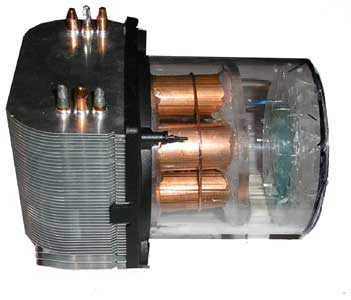You must have seen a lot of ionic wind cooling projects, however, the one we are going to discuss here is a step ahead from all of those. The best thing about this one is that it is simple to clean its grounding plates which is a herculean tasks with others. The first thing you will need to pick up for this project is acrylic, you can always buy some from a nearby local plastic dealer. You can even check out eBay where lots of people offer acrylic sliced into pieces. Next you need to go for a copper pipe, a high performing heat sink, wire, corona emitters or small nails, and a power source.

The first step is now to mark up the acrylic sheet that we purchased initially. For this purpose, you need to pick up the tube and scribe it with a marker on the inner end. If you get some extra marking over the acrylic or the tube, those can easily be rubbed with alcohol. Now use a scroll saw or band to cut around the outer surface of black line you scribed on the acrylic sheets.
After pursuing the task, you are now prepared with four acrylic discs, even if the cuts are not perfect it’s alright. You can then assemble the ion wind generator with the help of hot glue and make it airtight. Now take the disc and scribe few holes with points on three of those. The holes need to be 1/16th and 3/4th holes. Ensure, the spacing is for larger size for this purpose.
Now drill the holes in the first disk with the help of a 1/16th inch drilling machine. It is mandatory to drill the holes straight. Now, with the help of 3/4th inch drill bit drill out the holes in the same disk. Ensure the spacing is correct so that there is no overlapping.
Next, with the help of 18-inch copper wire segment strip the 3 inches of its other end and separate the strands in form of 2 different wires. Now insert the tacts in the holes in the acrylic dick and then wrap the wire near the heads with the help of wire as shown in the figure. Take the wire ends and twist those together and finally into one of the given wires. It will keep the whole thing neat and clean.You can now push the tach across the disk.
Now heat the glue and sandwich it between the acrylic disks. Let all cool down and cut the copper pipes in length of 3 inches. Test fit these pipes in the holes in the acrylic sheet that we drilled in last step. Thus, your complete grounding assembly is ready. You can seal the gaps with some hot glue but make sure the complete job is neat and clean.
Next part consists of ionic wind generator assembling. Start by test fitting the disks that were sandwiched with the pins at the end of the tube. Since we want the system to grasp some air, we will mark the hole lines near the gap on the top of cooler almost 1/4th inch beneath the lid, this will permit the system to draw in air. Strip the second wire by 10 inches and wrap it carefully near the copper tube assembly. Copper end needs to be twisted tightly for ensuring good contact.
Install the complete system into tube and insert the grounding tube in the rear end of the cooler. Be careful while doing this as it is the power source. Next part is molding the heat sink. You will have to disassemble the heat sink in order to modify it as per your needs.
For further details of these steps, you can check out the link given below.
Filed Under: Reviews


Questions related to this article?
👉Ask and discuss on EDAboard.com and Electro-Tech-Online.com forums.
Tell Us What You Think!!
You must be logged in to post a comment.